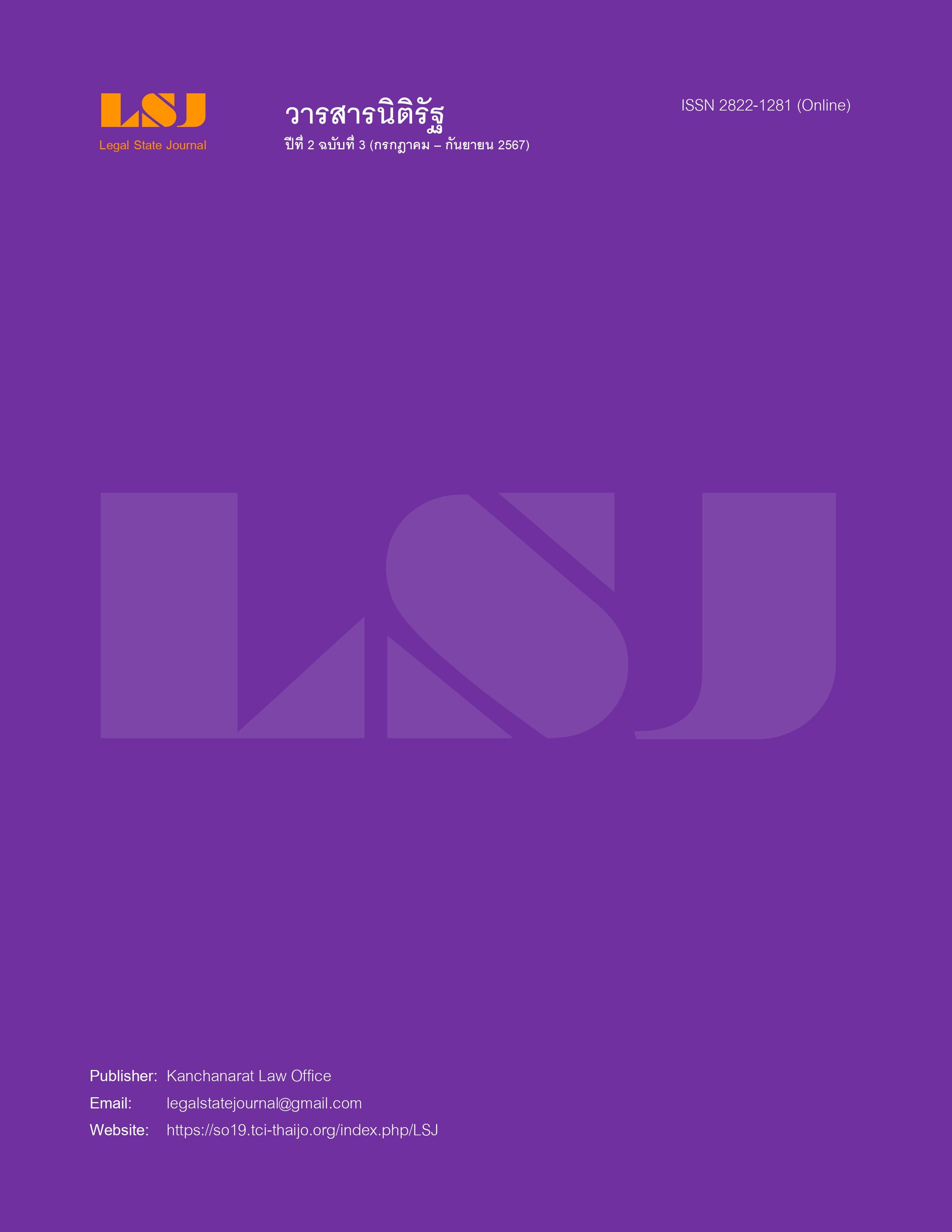Psychological Well-Being of School Administrators Under the Nonthaburi Primary Educational Service Area Office 1
Main Article Content
Abstract
This research article aims to study the level of psychological well-being of school administrators under the Nonthaburi Primary Educational Service Area Office 1; and compares the psychological well-being of these school administrators as classified by the demographical characteristics of educational qualification, work experience and school size. The samples used in the research were 297 teachers under the Nonthaburi Primary Educational Service Area Office 1 in the academic year 2023. The research instrument was a 5-point rating scale questionnaire with the Item-Objective Congruence at 1.00 and reliability of the questionnaire in question stood at 0.96. The statistics used in data analysis were frequency, percentage, mean, standard deviation, t-test, One-Way ANOVA and Scheffé’s multiple comparison method. Findings are as follows: (1) The level of psychological well-being of school administrators under the Nonthaburi Primary Educational Service Area Office 1 overall and for all aspects were expressed at a high level. (2) Teachers who differed in demographical characteristics of educational qualification did not evince parallel differences in their opinions regarding thepsychological well-being of school administrators overall at the statistically significant level of .05. (3) The teachers who differed in the demographical characteristics of work experience and school size exhibited concomitant differences in their opinions concerning the psychological well-being of school administrators overall and in all aspects at the statistically significant level of .05.
Article Details

This work is licensed under a Creative Commons Attribution-NonCommercial-NoDerivatives 4.0 International License.
The article published in the journal is the opinion and responsibility of the authors. Not related to Kanchanarat Law Office.
References
เฉลิมชาติ เมฆแดง, นันทพงศ์ หมิแหละหมัน, นรรถสรรพ เล็กสู่, วันฉัตร ทิพย์มาศ, ชัยวุฑ ตรึกตรอง และวัลภา หมิแหละหมัน. (2564). รูปแบบการพัฒนาความผาสุกในการปฏิบัติงานของครูในสถานศึกษาเอกชน สังกัดสำนักงานเขตพื้นที่การศึกษาประถมศึกษานครศรีธรรมราช เขต 4. วารสารวิชาการสถาบันเทคโนโลยีแห่งสุวรรณภูมิ, 7(1), 559-574.
ณัฐพร โตภะ และทิพย์วัลย์ สุรินยำ. (2560). การมองโลกในแง่ดี ความผาสุกทางจิตวิญญาณ ความเชื่ออำนาจภายในตนกับความหยุ่นตัวของนักศึกษาชั้นปีที่ 1 มหาวิทยาลัยแม่ฟ้าหลวง จังหวัดเชียงราย. วารสารสังคมศาสตร์และมนุษยศาสตร์, 43(2), 64-83.
ธีร์ สังขสัญญา, อรุณ จุติผล และสมาน อัศวภูมิ. (2563). รูปแบบการพัฒนาความผาสุกในการปฏิบัติงานของครูโรงเรียนเอกชนที่มีประสิทธิผล. วารสารบัณฑิตวิทยาลัย พิชญทรรศน์ 15(2), 57-70.
ธีรพัฒน์ วงศ์คุ้มสิน. (2561). ทุนทางจิตวิทยาเชิงบวก ความผาสุกทางจิตใจและความยึดมั่นผูกพันในวิชาชีพของข้าราชการครู สังกัดโรงเรียนในเขตกรุงเทพมหานคร. วารสารสังคมศาสตร์และมนุษยศาสตร์, 44(2), 211-248.
บุญชม ศรีสะอาด. (2560). การวิจัยเบื้องต้น (พิมพ์ครั้งที่ 10). สุวีริยาสาส์น.
ปาริชาติ เยพิทักษ์, ธีระวัฒน์ จันทึก และพิทักษ์ ศิริวงศ์. (2561). ปรากฏการณ์ความผาสุกขององค์การที่มีความหลากหลายในช่วงวัยทำงาน: การศึกษาทฤษฎีฐานราก. วารสารอิเล็กทรอนิกส์ Veridian มหาวิทยาลัยศิลปากร (มนุษยศาสตร์สังคมศาสตร์และศิลปะ), 11(1), 633-644.
ฤติมา บุญบำรุง. (2560). ความสุขในการทำงานของข้าราชการครู สังกัดสำนักงานพื้นที่การศึกษาประถมศึกษาชลบุรี เขต 3 อำเภอสัตหีบ. งานนิพนธ์การศึกษามหาบัณฑิต, มหาวิทยาลัยบูรพา.
สุรัติพิมพ์ ถ้ำทอง. (2554). ความสุขในการทำงานของครูระดับประถมศึกษาสังกัดสำนักงานเขตพื้นที่การศึกษาประถมศึกษาลำปาง เขต 3. การค้นคว้าแบบอิสระบริหารธุรกิจมหาบัณฑิต, มหาวิทยาลัยเชียงใหม่.
สำนักงานกองทุนสนับสนุนการสร้างเสริมสุขภาพ. (2555). การริเริ่มงาน Happy Workplace หรือองค์กรแห่งความสุข. ค้นจาก https://www.thaihealth.or.th/การริเริ่มงาน-happy-workplace-หรือองค
อาภากร เปรี้ยวนิ่ม, พูลพงศ์ สุขสว่าง และปิยะทิพย์ ประดุจพรม. (2563). การพัฒนามาตรวัดความผาสุกทางจิต. วารสารพยาบาล, 69(2), 30-36.
อิทธิพัทธ์ สุวทันพรกูล. (2561). การวิจัยทางการศึกษา: แนวคิดและการประยุกต์ใช้. โรงพิมพ์แห่งจุฬาลงกรณ์มหาวิทยาลัย.
Cohen, L., Manion, L., & Morrison, K. (2018). Research methods in education (8th ed.). Routledge.
Dive, B. (2004). The healthy organization. DMA Consultancy.
Gopalakrishnan, S, & Damanpour, F. (1994). Patterns of generation and adoption of innovation in organizations: Contingency models of innovation attributes. Journal of Engineering and Technology Management, 11(2), 95-116.
Lowe, G. S. (2004). Healthy workplace strategies: Creating change and achieving results. Graham Lowe.
Management 2008’s Weblog. (2552). Change… เพื่อสร้างความสุขในองค์กร. ค้นจาก https://management2008.wordpress.com/2009/05/22/change-เพื่อสร้างความสุขในอง
Ryff, C. D. (1989). Happiness Is Everything, or is it? Explorations on the meaning of psychological well-being. Journal of Personality and Social Psychology, 57(6), 1069-1081.
Ryff, C. D., & Keyes, C. L. M. (1995). The structure of psychological well-being revisited. Journal of Personality and Social Psychology, 69(4), 719-729.
Smet, A. D., Loch, M. & Schaninger, B. (2007). Anatomy of a healthy corporation. McKinsey Quarterly.

